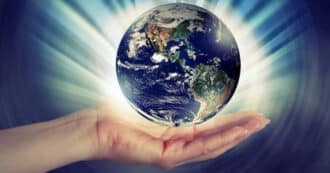By Rachel Cohen – Environmental sustainability is a term that may be familiar, but what does it actually mean? Environmental sustainability can encompass areas of environmental work from environmental justice to renewable energy.
The U.N. Environment Programme defines the term as “making life choices that ensure an equal if not better way of life for future generations.”
This means we need to find an equilibrium in improving and sustaining life without the strain on the earth. This is hard for us to do as we live on a planet with finite resources, yet act like there are an infinite amount of resources.
Topics Covered Under Environmental Sustainability?
Environmental sustainability efforts can range from local issues to global issues. An example of a local issue could be a park covered in liter. In response to this, a group may organize a trash clean up.
Cleaning up the trash protects the animals and the ecosystem, ensuring survival for future generations. These actions help to make a difference.
A global issue is the effort to reduce greenhouse gases. To reduce humanity’s carbon footprint, many are working on solutions. This can include learning how to better produce and use renewable energy, change agricultural methods or other techniques.
Why Is Environmental Sustainability Important?
Environmental Sustainability is important because we’re living in a way that is unsustainable resulting from unsustainable habits that will greatly affect future generations. We’re using up our natural resources at an unprecedented rate, rainforests are being destroyed, overfishing is a common practice and overall economic growth is more important than protecting earth.
Our consumeristic way of life has greatly impacted our need for environmental sustainability. In a 2015 study it was found that the production and use of household goods and services are responsible for 60% of global greenhouse gas (GHG) emissions.
Other areas of life have impacts on GHGs such as fast fashion, which accounts for 10% of global emissions. These are not environmentally sustainable practices, as they continue to pollute the earth and cause harm, greatly affecting present and future generations.
The History of Environmental Sustainability
Some may think that environmental sustainability is a new concept, yet its thousands of years old. Under the umbrella term ‘environmental sustainability’ there’s environmentalism, which is the concern and action of protecting the environment.
Humans always had a deep connection to the earth, before industrialization and exponential population growth. The first record of environmental awareness was recorded 5,000 years ago in Buddhist texts which praise wild forests in hymns.
Though this might be different than how we think about environmental sustainability today, it supports the notion that this has always been an important aspect of human life. Today, the concept of nature and our connection to it has changed.
As the world became more industrialized writers such as Aldo Leopold began urging people to look at the beauty of the earth. Looking at the earth for beauty was popular during the 1800s and was heavily influenced by the Christian religion. This view was more anthropocentric which is still seen today.
Native Americans and Environmentalism
Native Americans have been at the forefront of environmentalism for a long time. Their view of the world sees the land and environment as two things intertwined and dependent on one another. They use sustainable practices such as crop rotation so as to not deplete the soil of its nutrients.
This way of thinking has been ignored, leading us to overconsumption, nonrenewable resources, and fossil fuel-dependent lifestyles greatly impacting climate change. Adopting a more intertwined understanding regarding the environmental impact of our actions may have put us in a better situation.
Environmental Sustainability In The 1960’s
How many of us realize that sustainability efforts such as combating climate change and focusing on renewable resources is thanks to the work done in the 1960s. The environmental movement can be linked back to the work of Rachel Carson‘s 1962 publication of “Silent Spring”.
“Silent Spring” exposed the harm that the use of DDT (a pesticide) had on the environment. Carson showed the link between the use of pesticides, harm to the planet, and people, which changed thinking in the environmental movement.
Environmentalism developed and was no longer just about the earth’s beauty but it was to understand the interconnections between the environment and humanity. We see this through environmental justice issues.
This was a time of drastic changes in social attitudes and attitudes towards the American government. During the 1960s there was the Civil Rights movement which showed people the extreme inequality occurring around the world and just outside their houses. People were beginning to turn on the government and call for more action which ultimately helped change the course. This can be seen in the wave of legislation signed in the 60s.
Environmental Legislation
During the movement of the 1960s important environmental regulations were signed that changed the course of our world and helped to curb some global warming issues.
The Clean Air Act (1963) was signed by Lyndon Johnson. This limited emissions, with the goal of cleaning up the air. Specifically, this banned lead gasoline which lowered the levels of lead in children’s blood.
The Endangered Species Act (1973), was signed by Richard Nixon. This has saved over 40 species which has been one step to achieve environmental sustainability and to save biodiversity.
The Montreal Protocol changed the world for present and future generations as it reduced the use of chlorofluorocarbons and hydrochlorofluorocarbons. These molecules were being trapped in the ozone layer and creating large holes and leading to global warming.
The Clean Water Act was signed by Nixon in 1972. This act was signed because the Cuyahoga River caught fire due to chemical fertilizers, trash, and other impurities in the water.
The Future of Environmental Sustainability
As we move into a world where we’re trying to avoid a global temperature increase of 1.5 C we have to think about sustainable development goals. The U.N. published 17 sustainable development goals in 2015, yet we’re still no close to reaching any of them.
The goals cover areas of water pollution, toxic substances, clean energy, freshwater, the environment, sustainability, and the living world. Essentially, the U.N. is calling for all aspects of our wasteful life to be examined.
People like Greta Thunberg have been a big push into changing our ways. Thunberg as a young teenager captured the world’s attention as the spokesperson for future generations. Thunberg isn’t scared to call out politicians as she did in her EU Conference Speech. She understands the severity of the problem and urges everyone to work towards a more sustainable future.
Many are joining the fight for sustainability as they are concerned with the long term consequences. The fight is seen on social media through hashtags and accounts that work to spread awareness.
Through social media, further sustainability concerns have been raised, related to human health, waste generation, the overuse and destruction of natural resources, fossil fuels, pollution creation, global warming and environmental justice. Many non profit organisations are sprouting up globally to combat energy use, water resources, sustainable energy, the environmental impacts of the western lifestyle and ways to reduce further damage.
The future can be uncertain, but we all already know that if we don’t change behaviors we won’t have much of a planet to rely on. We need to stop living as if the world has infinite resources when there’s only a finite amount.
Religion and Environmental sustainability
Numbers 2:2 – The Israelites shall camp each with his standard, under the banners of their ancestral house; they shall camp around the Tent of Meeting at a distance.
Indigenous to the Land, From Eco Bible Volume 2
Rabbi Abraham ben Meir ibn Ezra (11th–12th century) understands “standard” (otot) to mean pictures: the tribe of Reuben had a person with flowers, the tribe of Judah had a lion, the tribe of Ephraim an ox, the tribe of Dan an eagle, and the tribe of Asher an olive tree. Most of the tribal images were of animals, trees, or plants, showing their rootedness in the land. Living in the Sinai desert, the Israelite tribes were on their way to becoming indigenous to the Land of Israel. Being an indigenous people continued for about 1,500 years (with a 70-year break in Babylon) until the time of the Byzantines. Being indigenous meant being connected to and knowing the contours of the land and having tribal identities. This intimacy with the land enabled a greater degree of sustainability than we know today.
Contemporary Native American farmer Vena A-dae Romero beautifully explains the importance of having an indigenous relationship with the land:
Indigenous people are as much a part of the land as the land is part of us. We cultivate the land while the land cultivates us. This relationship that has supported my people since time immemorial is remembered daily when we place our fingers in the dirt, pull the weeds from our fields, or plant our seeds with water, prayer, and hope, cook the food which we grow, and ingest the world with each bite of food we eat.
A 2021 study found that indigenous people in the Amazon practiced forest conversation for thousands of years. As lead investigator and archaeobotanist Dolores Piperno said, “Indigenous people have always played an important role in the sustainable use of the forest and the conservation of biodiversity, and they should continue to be central to it, especially because of their deep knowledge of the forest and its relevance in their daily lives.”
* Featured image source








